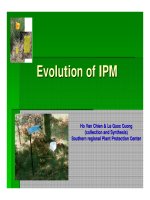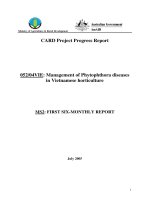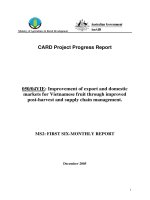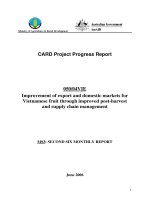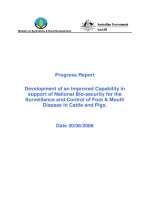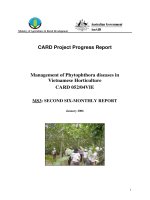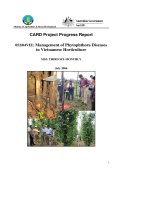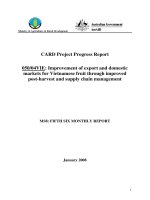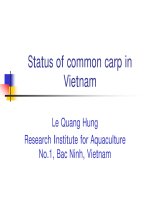Báo cáo nghiên cứu khoa học " Development of an Improved Capability in support of National Bio-security for the Surveillance and Control of Foot & Mouth Disease in Cattle and Pigs - Milestones 7 " docx
Bạn đang xem bản rút gọn của tài liệu. Xem và tải ngay bản đầy đủ của tài liệu tại đây (70.96 KB, 12 trang )
Ministry of Agriculture & Rural Development
Progress Report
Development of an Improved Capability in
support of National Bio-security for the
Surveillance and Control of Foot & Mouth
Disease in Cattle and Pigs.
Milestones 7: 4
th
6 monthly Report
Date 01/01/2007 to 30/06/2007
Table of Contents
1. Institute Information ____________________________________________ 3
2. Project Abstract _______________________________________________ 4
3. Executive Summary ____________________________________________ 4
4. Introduction & Background ______________________________________ 5
5. Progress to Date _______________________________________________ 6
5.1 Implementation Highlights ___________________________________ 6
5.2 Smallholder Benefits ________________________________________ 7
5.3 Capacity Building___________________________________________ 8
5.4 Publicity __________________________________________________ 8
5.5 Project Management ________________________________________ 8
6. Report on Cross-Cutting Issues __________________________________ 8
6.1 Environment_______________________________________________ 8
6.2 Gender and Social Issues ____________________________________ 8
7. Implementation & Sustainability Issues ____________________________ 9
7.1 Issues and Constraints ______________________________________ 9
7.2 Options ___________________________________________________ 9
7.3 Sustainability ______________________________________________ 9
8. Next Critical Steps ____________________________________________ 10
9. Conclusion __________________________________________________ 10
10. Statuatory Declaration _________________________________________ 11
11. Project progress against proposed objectives, outputs, activities
and inputs___________________________________________________ 16
1. Institute Information
Project Name
Vietnamese Institution
Regional Animal Health Centre, Ho Chi
Minh City (RAHC-HCMC), South Vietnam.
Vietnamese Project Team Leader
Dr. Dong Manh Hoa
Australian Organisation
A
ustralian Animal Health Laboratory
(AAHL), PMB 24, Geelong, 3213,
Australia
Australian Personnel
Mr Chris Morrissy
Date commenced
01/06/2005
Completion date (original)
01/06/2008
Completion date (revised)
Reporting period
01/07/2006 – 31/12/2006
Contact Officer(s)
In Australia: Team Leader
Name:
Mr Chris Morrissy
Telephone:
+61 3 5227 5000
Position:
Diagnostic Virologist
Supervisor Mammalian
Virology
Fax:
+61 3 5227 5555
Organisation
Australian Animal Health
Laboratory (AAHL), PMB 24,
Geelong, 3213,
Australia
Email:
In Australia: Administrative contact
Name:
Mr Chris Morrissy
Telephone:
+61 3 5227 5000
Position:
Patents Contracts Officer
Fax:
+61 3 5227 5555
Organisation
Australian Animal Health
Laboratory (AAHL), PMB 24,
Geelong, 3213,
Australia
Email:
chris.morrissy@csir
o.au
In Vietnam
Name:
Dr. Dong Manh Hoa
Telephone:
+ 84 8 8568220
Position:
Director
Fax:
+ 84 8 8569050
Organisation
Regional Animal Health
Centre, Ho Chi Minh City
(RAHC-HCMC), South
Vietnam.
Email:
n
2. Project Abstract
The project’s purpose is to determine why there are vaccine failures, and to
investigate what serotypes of FMDV are circulating in Vietnam so that the
correct vaccines can be used for these serotypes. Regional laboratories are
setup with the reagents and methods to allow a diagnostic capability for
FMDV diagnosis and serology. Control strategies for understanding of FMD
epidemiology have been implemented through veterinary and laboratory
training workshops and laboratory testing for both virus typing and sero-
surveillance have begun. The project has highlighted the importance of having
a laboratory network to identify what is happening in the field and how to
prevent and control disease outbreaks. The pilot zones are established in
provinces near the borders of Vietnam to study serotypes circulating in
Vietnam and to determine their origin. The quality and collection of samples
have increased giving more data on the FMD situation in Vietnam. Molecular
epidemiological studies of the FMDV isolates in these provinces will provide
insights to the effectiveness of border control and the origin of FMDV
circulating in Vietnam each year. Virus isolation and molecular studies have
started to be carried out on FMD samples from the field. A diagnostic capacity
for FMD would allow the early detection and identification of disease enabling
better control of disease and help reduce loss of livestock and so productivity.
3. Executive Summary
The main focus of this reporting period was to improve the data collected from
the field studies for sero-surveillance and from disease investigations. The
Regional Animal Health Centre in Ho Chi Minh City continued to train and
support the field veterinarians on how to collect samples and how to collect
information necessary for the history of the animals for the villages in the
project. The data on the animals from the sero-surveillance is critical to allow
analysis of the data and for making decisions on cause of vaccine failure.
The establishment FMD diagnostics in the collaborating laboratories is
continuing with the HCMC laboratory having FMD diagnostics established for
virus isolation, ELISA and PCR. The HCMC laboratory is preparing its own
ELISA antigen for use in the project as part of training to become self
sufficient. One scientist from the Regional Animal Health laboratory HCMC
and one scientist from NCVD Hanoi trained at AAHL in FMD diagnostics, with
a focus on cell culture and QA.
Two AAHL consultants also carried out training at the HCMC and Hanoi
laboratories with one consultant also visiting the laboratories at Can Tho and
Da Nang. The focus of the visit to the four collaborating laboratories was to
implement the use of the Vietnam antigen produced at HCMC into the FMD
ELISAs. The first consultant reviewed virus isolation, molecular and ELISA
technologies for diagnosis of FMD and reviewed ELISA results from the sero-
surveillance. Quality Assurance (QA) was again a important part of the
training and QA records were reviewed during training visit to each laboratory.
The project has been asked to attend a number of national meetings to advise
the Vietnamese Government and DAH on control of FMD.
Avian Influenza (AI) continues to delay the sero-surveillance in the field as
field staff deal with the AI outbreak. .
4. Introduction & Background
Objectives of the project:
1. To establish an effective laboratory network for the diagnosis and
control of FMD by the provision of resources and training of staff in
required methods and quality assurance.
2. To provide accurate data to explain failure of vaccination to control
FMDV and to develop new effective vaccine application strategies.
Completing these objectives will improve the diagnostic capability of the
Veterinary laboratories in Vietnam and the training of DAH veterinarians
in disease investigation and control. This will strengthen the profile of
DAH which will play a vital role in making Vietnam more economically
competitive. Improved animal health will lead to an increase in rural
productivity though increased animal production and indirectly in
increased crop production. Healthy animals will enable small farmers to
be more competitive in the local market. Control of FMD and animal
diseases in general will give poor farmers a more stable income stream
and reduce their vulnerability to natural and economic problems.
Establishing a diagnostic network which extends from the North to South
Vietnam, from the laboratory to the farm level, reinforced by training and
education, will give Vietnam a working model on which to base disease
control. This will directly increase the competitiveness and productivity of
the national agricultural system which includes the major areas of
concern including the Mekong Delta and the Central Coast.
Implementation Approach and Strategy
The project approach is thought to be the most appropriate for developing
an understanding of FMD epidemiology in Vietnam. The approach for
technology transfer is well established at AAHL and has been successfully
applied in previous projects in Vietnam, Thailand and Indonesia. The field
studies and epidemiology and sero-surveillance approaches have been
designed and planned in conjunction with DAH to provide the maximum
necessary information to demonstrate the FMD situation in Vietnam and
the effectiveness of FMD vaccines. The diagnostic technologies that will
be used in this approach are the standard diagnostic tests in use
throughout the world to study FMD as directed by OIE.
AAHL has a lot of experience with field surveys for prevalence of
antibodies, as in the ACIAR projects in Laos and Thailand on FMD. The
Philippines is another example where OIE standard diagnostic tests are
being used to control and eradicate FMD.
5. Progress to Date
5.1 Implementation Highlights
Main achievements for this reporting period were:
• Further training of field veterinarians was carried out with feedback of
the results and experiences from first two rounds of testing. The aim was
to increase the quality of sample and data collection to ensure issues of
vaccine failure can be addressed.
• Training of laboratory staff at AAHL, one scientist from the RAHO-HCMC
and one scientist from NCVD-Hanoi trained at AAHL in FMD
diagnostics, with a focus on cell culture and QA. The scientist from
Hanoi also trained in FMD ELISA. Training was carried out under a
quality system emphasizing the importance of Quality Assurance in the
laboratory focusing on test maintenance, record keeping and data
collection.
• A consultant from AAHL (project leader) reviewed data from the field in
the HCMC laboratory and outlined the improved required in data
collection. A plan was made to retest samples to compare antibody titres
for samples from the provinces to allow identification by serology of the
circulating isolate.
• AAHL consultant reviewed cell culture and virus isolation for growth of
FMD isolates from the field. Cell culture is important to grow FMD virus
to allow further analysis of FMD field isolates by PCR and sequencing.
ELISA and molecular techniques were also reviewed. Again Quality
Assurance, record keeping and data collection was emphasized.
• The consultant from AAHL also reviewed the transfer of ELISA
technology to each laboratory and the implementation of a Quality
Assurance system into the laboratory. The ELISA antigen from HCMC
was taken to each laboratory to compare the use of this Vietnam antigen
to the antigen from AAHL. The antigen from Vietnam was found to give
similar results and the production of antigen was a success.
• Sampling for next round sera collection completed for each province for
epidemiological studies and sero-surveillance. The collection of tissue
samples from outbreaks continued to increase giving valuable
information on the serotypes circulating in Vietnam
• Virus isolation and cell culture in the process of being setup at the Hanoi
laboratory.
• The supply of consumables and further reagents for testing of samples
by FMD ELISA, molecular technology and cell culture were supplied as
requested.
Report from Vietnam:
ACTIVITIES from Jan 1
st
2007 to May 30
th
2007
1.Training
No. Date & place Subject Person in
charge
Remark
1 March, 2007
- Expert from AAHL
working in Viet Nam
- Chris
Morrissy
- Darren
Schafer
- Testing and
validation the
first batch of
FMDV serotype
O, A and Asia 1
ELISA antigen
produced by
RAHC-HCMC
2 April 18 –
May 16,
2007,
Australia
- ELISA in advance
training
- Virus isolation
- Chris
Morrissy
- Lynda
Wright
- 1 Participant
from RAHC-
HCMC
2. Field activities
2.1.1. Visit to 8 provinces in the project (Middle and South Vietnam), March.
2007.
• Transfer the equipments and documents ( form, questionnaire) for
sample
collection.
• Transfer money for sample collection.
• Feed back the results from third testing round and share the
experience on
sample collection with the field veterinarian staff to increase the
quality of collected samples .
• Staff in charge : Dr. Hoa, Dr. Vu , Dr. Ha ( RAHC-HCMC) - Dr.
Quan , Dr.Quang
(RAHC-Da Nang) – Dr. Thanh , Dr. Dung ( RAHC-Can Tho)
2.1.2. Visit to 2 provinces in the project (North Vietnam ), March. 2007
• Transfer the equipments and documents ( form, questionnaire) for
sample
collection.
• Transfer money for sample collection.
• Feed back the results from third testing round and share the
experience on
sample collection with the field veterinarian staff to increase the
quality of
collected samples .
• Staff in charge : Dr. Cam , Dr. Tung ( NVDC- Ha Noi)
2.2. Collect sera samples from 10 provinces for the four round of
surveillance , 120 cattle
sera and 120 pig sera from each province.
2.2.1 NVDC-Ha Noi : 02 provinces (Quang Ninh and Lang Son) , total 480
sera samples.
2.2.2 RAHC-Da Nang : 02 provinces (Kontum and Quang Nam) , total 480
sera samples.
2.2.3 RAHC-Can Tho : 02 provinces (An Giang, Kien Giang ), toatl 480 sera.
2.2.4 RAHC-HCMC : 04 provinces ( Binh Phuoc, Tay Ninh, Long An, Dong
Thap), total 960 sera
2.3 Collect tissue samples for FMDV typing
2.3.1 NVDC-Ha Noi : 98 tissue samples from the North ,
2.3.2 RAHC-HCMC : 123 tissue samples from the South .
3. Laboratory Activities
3.1 National Vaterinary Diagnostic Center- Ha Noi ( NVDC-Ha Noi):
3.1.1 Testing on tissue samples for FMDV typing : 98 samples, 89 of the are
serotype O and 9 are serotype Asia 1.
3.1.2 Testing on sera for FMDV antibodies detection : 480 sera , test
finished
3.2 Regional Animal Health Center Da Nang (RAHC-Da Nang)
3.2.1 Sending 480 sera to RAHC-HCMC for retest : 480 sera
3.3 Regional Animal Health Center Can Tho (RAHC-Can Tho)
3.2.1 Sending 480 sera to RAHC-HCMC for retest : 480 sera
3.4 Regional Animal Health Center HCMC(RAHC-HCMC)
3.4.1 Testing on tissue samples for FMDV typing : 123 samples, 01 of them
is serotype
A , 116 samples are serotype O and 06 samples are negative
Remark: test is cover 03 serotype : serotype A, O and Asia 1
3.4.2 Testing on sera for FMDV antibodies detection : 1920 sera ( 960 sera
in the region and retest 960 sera from RAHC-Can Tho and Da Nang ).
Test finished
3.4.3 Isolate FMDV by BHK cell line from 20 selected samples , 01 serotype
A and 19 serotype O.
3.4.4 Production FMDV ELISA antigen:
Produce the first batch of FMDV antigen
• Serotype O: 35 ml
• Serotype A : 35ml
• Serotype Asia 1: 35ml
Testing this antigen with reference sera panel from AAHL with the
expert from AAHL.
Report by: Ngo Thanh Long
5.2 Smallholder Benefits
All pig and cattle and producers are potential beneficiaries. Those that take up
the advice and use vaccine according to recommendations will benefit
financially through reduced losses due to death and disease in their cattle and
pigs. The benefits of a more profitable farming operation flow to all family
members. Farmers and district veterinarians will have improved knowledge
and skill in disease prevention, knowledge on the selection of the right
vaccine and improving the efficacy of vaccination
5.3 Capacity Building
Training and education of field veterinarians in disease prevention, disease
investigation and sample collection has continued with lessons learnt from the
first round of sero-surveillance and sample collection. This training has
already shown an impact with an increase in quality of sample collection and
number of samples collected and submitted to the laboratory. The project has
provided training and technology transfer of FMD diagnostics to each
laboratory involved in the project. Reagents and standard methods have been
supplied to each laboratory giving them the diagnostic capability for FMDV
diagnosis and serology using ELISA technology, this technology is now being
practised at each laboratory. The RAHC-HCMC has virus isolation and cell
culture techniques established and has begun to use molecular technology
and serology by VNT using cell culture. RAHC-HCMC now has capacity to
carry out RT-PCR for FMD for detection of FMD antigen and for sequence
analysis.
5.4 Publicity
The CARD AusAID project has received publicity through the training
programs and also through the achievements so far in the project in
understanding FMD in Vietnam. FMD is a disease on importance in Vietnam
and this has put our project into the lime light. The project has been publicised
through a press release in Australia and articles in news letters including the
SEAFMD newsletter and on the internet. The results from the project have
been presented at OIE/SEAFMD meetings during the project.
5.5 Project Management
Implementation of the project is on schedule. AAHL has kept the project on
target and has supported or requests from the Vietnamese partners. Training
has been carried out in Australia and Vietnam with both partners benefiting
from the information that is being generated.
Implementation in Vietnam is also continuing to go well. Trainees have been
supplied in a timely manner, from DAH. The field work has been organised
well with data and samples being collected from farms in each pilot zone.
Training and the transfer of information to other regional laboratories in
Vietnam is also occurring, RAHC-HCMC is supplying support to these
laboratories.
6. Report on Cross-Cutting Issues
6.1 Environment
No direct environmental impacts associated with project activities have been
identified. On a broader scale, the intention is that pig and cattle farming will
become more efficient through a reduction in animal death and disease.
Environmental benefit will result through more efficient utilization of resources
such as animal feed, the energy to provide animal feed and to run other
aspects of the farm.
6.2 Gender and Social Issues
Application of new diagnostic tests will improve the ability of regional and
provincial diagnostic units to quickly and accurately assess FMD outbreaks,
enabling rapid and appropriate measures to be applied to control disease.
These benefits will begin during the project and continue to accrue with
continued application. The beneficiaries of this project will be both large and
small farms and particularly smallholder farmers whose animals and incomes
will be protected by better disease diagnosis, management and control. Since
women at the village level are the primary animal handlers and managers,
they will be major beneficiaries of the final outcome of better diagnosis and
control of animal diseases.
7. Implementation & Sustainability Issues
7.1 Issues and Constraints
DAH continues to spend time controlling the AI outbreaks in Vietnam and this
has made there workload high. The collection of samples continues to be
made more difficult by the need to train all veterinarians in each province in
data collection and on how to collect samples, collection of blood and how to
restrain cattle. This increased training need has highlighted the need for
further training of field veterinarians throughout Vietnam in disease
investigation techniques with a focus on sample collection and data collection.
There is a need for further input in this area, large scale training of field
veterinarians to ensure better knowledge and control of disease in Vietnam.
This could be achieved though better collaboration of aid agencies in Vietnam
especially those supplying training for AI. Training in data analysis by DAH
staff is also an area that needs further input.
7.2 Options
The government of Vietnam is looking at increasing the support to DAH and
has increased funding for AI diagnosis and is looking to do the same for FMD
diagnosis. The increased funding for AI has seen laboratories updated with
new equipment some of which will improve all disease diagnosis which
includes FMD.
The money available to improve AI diagnosis can improve all disease
diagnosis if this money is used wisely, e.g. in training field veterinarians in AI
diagnosis, the training should be general to cover all diseases including FMD,
CSF and other diseases of importance in Vietnam. Also in improving AI
diagnosis in laboratories the training should emphasize how improvement can
be applied to all areas of diagnosis, eg quality assurance in the laboratory.
7.3 Sustainability
The DAH laboratories appear to be well supported by the central government.
The DAH laboratories are also receiving increased support from overseas
funding agencies as part of the AI campaign to improve laboratory facilities.
RAHC-HCMC is gaining in confidence as an institution. This confidence is
beginning to be passed on to other DAH laboratories. The DAH scientific staff
are quick to understand new information and are energetic in its
implementation. People have an obvious desire to do their jobs well. This
desire is obvious in staff in RAHC-HCMC and other laboratories. The
laboratories just need technical support to be encouraged to carry out the
techniques that they need for diagnosis and research.
The project is following a well tried model for successful technology transfer,
of demonstration and teaching of the technology in the donor facility followed
by supply of reagents for implementation by the trainees at their own initiative
in the recipient laboratory, subsequently backed up by consultancy visits to
the recipient laboratory for support and fine tuning. A useful indicator of likely
success is the initiative and ability of the trainees to make a useful attempt at
implementation by themselves. DAH and NAVETCO staff show a high level of
involvement in this way. The RAHC-HCMC now has established ELISA, cell
culture and molecular technologies.
The AusAID funded CSFV project, that linked DAH, NaVetCo and AAHL prior
to this project, is proving sustainable. NAVETCO and DAH not only maintains
the diagnostic capability developed at that time, but on its own initiative and
unassisted by AAHL is conducting training courses and technology transfer to
other labs in Vietnam.
8. Next Critical Steps
In the next 6 months AAHL staff will review the project outputs and to examine
the information collected so far in the project and continue to provide support
to the establishment of the technologies transferred to the laboratories. The
next round of the sero-surveillance for the collection of the samples will be
implemented with a greater emphasis on collection of all the data on the
history of the aniamals being bled. In the next 6 months AAHL will finalise the
transfer of technologies for FMD diagnosis and evaluate each laboratories
capability to carry out FMD diagnosis. HCMC-RAHC will continue to use cell
culture techniques to grow FMD isolates from the field and produce ELISA
antigen for the laboratories in the project. The FMD isolates from the field will
be sent for further analysis of these isolates by PCR and sequencing. AAHL
will collaborate with the World Reference Laboratory (WRL) to analyse the
sequence data obtained from Vietnam FMD isolates. Two trainees will visit
AAHL to be trained in virus isolation and cell culture. AAHL consultants will
visit the laboratories to examine data from project and to review the
techniques for FMD diagnosis.
9. Conclusion
The project activities are ahead of schedule with training and this will allow
more time for the laboratories in the project to take up the technology. The
RAHO-HCMC are providing further support and training to field veterinarians
carrying out the sero-surveillance to improve sample and data collection from
the field. The sero-surveillance continues to be carried out but the schedule
does experience delays in collecting samples from the field to due to the AI
workload. The project has highlighted field veterinarians need further training
in the collection of data and how to ensure the correct information is obtained
from the farmer. The staff at RAHC-HCMC will continue to deal directly with
the veterinarians in the field to ensure the correct information is collected.
Training of the laboratories in FMD diagnostics was completed, with a training
course for 2 trainees from the RAHO-HCMC and NCVD –Hanoi laboratories
held at AAHL. The RAHC-HCMC continues to carry out in country training
where necessary to ensure problems are addressed with the transfer of
technology to the laboratories in the project. The establishment of cell culture
has allowed the growth of FMD isolates from the field that could not be
previously identified at RAHO-HCMC and is now being implemented at
NCVD-Hanoi. The growth of isolates has also allowed sending of higher
quality samples to the world reference laboratory at Pirbright, UK, and
allowing results to be returned in a quicker timeframe. The introduction of
molecular techniques at RAHC-HCMC has allowed sequencing results to be
obtained in real time allowing DAH Vietnam to make informed decisions about
serotypes of FMD circulating in Vietnam and the correct vaccine to use in
each region to control FMD. AAHL, DAH and WRL have cooperated on
analysis of the sequence data from Vietnam isolates.
This project continues to be important project for Vietnam with the importance
of FMD increasing due to the large outbreaks that have occurred in Vietnam
in 2006. The Vietnam Government and DAH have invited AAHL to give advice
on FMD control at meetings implementing a 5 year plan to control FMD.
